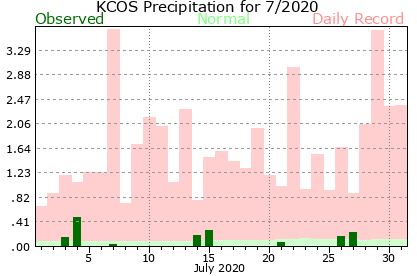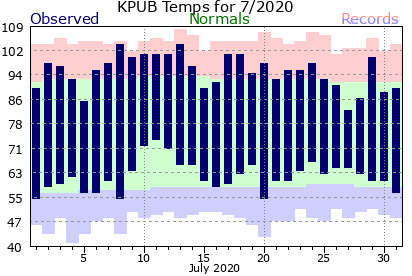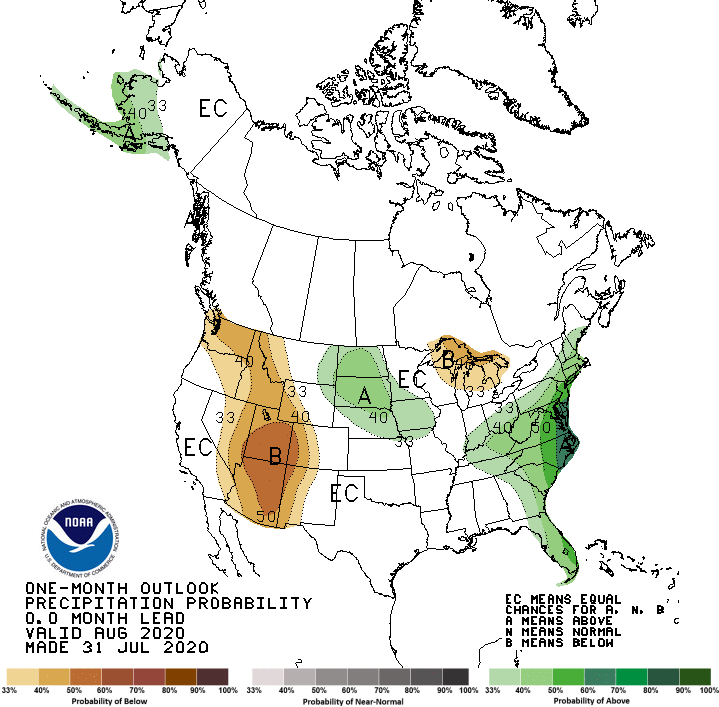July of 2020 continued the roller coaster type of weather pattern through the first half of the month, with hot and dry conditions followed by cooler and wetter conditions, especially across the southeast plains, where a few frontal passages brought bouts of severe weather to eastern Colorado. The latter portion of July saw an increase in monsoonal moisture across the state, with cooler and wetter conditions experienced into the end of the month. For the month of July as a whole, above to well above normal temperatures were experienced across all of south central and southeast Colorado, with near to below normal precipitation across the eastern mountains and immediate adjacent plains, and at and above normal precipitation experienced across most of south central Colorado and across portions of the lower Arkansas River Valley.
The following graphics depict monthly temperature and precipitation departures from normal across the state for the past month of July.
 |
 |
The preliminary average temperature in Alamosa for the past month of July was 65.6 degrees. This is 1.0 degrees above normal and makes July of 2020, tied with July of 2006 and July of 1949, as the 28th warmest July on record in Alamosa. This, remains well behind the warmest July, 2011, when the average July temperature was 68.4 degrees in Alamosa. Alamosa recorded 1.58 inches of precipitation through the month of July. This is 0.61 inches above normal and makes July of 2020 the 18th wettest on record. This remains well below the wettest July, 2017, when 3.52 inches of precipitation was recorded in Alamosa. Alamosa set 2 record daily low temperatures, 2 daily record high temperatures and 1 monthly record low temperature in July. This includes July 1st, when a new daily and monthly record low temperature of 28 degrees was set,. as well as July 10th, when the record low temperature of 37 degrees was tied early in the morning and a new record high of 92 degrees was set in the afternoon.
 |
 |
The preliminary average temperature in Colorado Springs for the past month of July was 74.2 degrees. This is 3.3 degrees above normal and makes July of 2020 the 8th warmest July on record in Colorado Springs. This remains well below the warmest July, 2003, when the average monthly temperature was 75.8 degrees. Colorado Springs recorded 1.53 inches of precipitation through the month of July. This is 1.31 inches below normal and makes July of 2020 the 24th driest July on record in Colorado Springs, though this is well above the driest July, 2008, when only 0.28 inches of precipitation was recorded in Colorado Springs. Colorado Springs set a record high minimum temperature of 66 degrees on July 13th. Colorado Springs also recorded 17 days with high temperatures at or above 90 degrees. This makes July of 2020 the 9th most 90 degree days recorded in July on record, though well below July of 2003, when there were 24 days with temperatures of 90 degrees or warmer.
 |
 |
The preliminary average temperature in Pueblo for the past month of July was 78.9 degrees. This is 3.1 degrees above normal and makes July of 2020, tied with July of 2018, as the 14th warmest July on record in Pueblo. This remains well below the warmest July, 2003, when the average monthly temperature in Pueblo was 81.2 degrees. Pueblo recorded 1.31 inches of precipitation through the month of July, which is 0.75 inches below normal. Pueblo set a record high minimum temperature of 74 degrees on July 11th. Pueblo also recorded 9 days with high temperatures at or above 100 degrees. This makes July of 2020, tied with July's of 2002, 1981, and 1964 as the 7th most 100 degree days recorded in July on record in Pueblo. This is well below July of 2003, when there were 23 days with temperatures of 100 degrees or warmer in Pueblo. Pueblo did, however, have 6 straight days (July 8th-13th) in which the high temperature reached 100 degrees or greater. This ties with 3 other occurrences, as the 6th longest consecutive streak in which the high temperature was at or above the century mark in Pueblo. This remains well below the 14 day stretch in July of 2012, with high temperatures at or above 100 degrees.
 |
 |
Looking ahead into August in Alamosa, the average high temperature and low temperature of 81 degrees and 48 degrees on August 1st, cool to 77 degrees and 43 degrees by the end of the month. The average temperature for the month of August in Alamosa is 62.7 degrees. Alamosa averages 1.27 inches of precipitation through the month of August. On average, August is the wettest month of the year in Alamosa.
In Colorado Springs, the average high temperature and low temperature of 84 degrees and 57 degrees on August 1st, cool to 80 degrees and 53 degrees by the end of the month. The average temperature for the month of August in Colorado Springs is 68.7 degrees. Colorado Springs averages 3.34 inches of precipitation through the month of August. On average, August is the wettest month of the year in Colorado Springs.
In Pueblo, the average high temperature and low temperature of 91 degrees and 59 degrees on August 1st, cool to 87 degrees and 54 degrees by the end of the month. The average temperature for the month of August in Pueblo is 73.4 degrees. Pueblo averages 2.32 inches of precipitation through the month of August. On average, August is the wettest month of the year in Pueblo.
Below is the Climate Prediction Center's (CPC) temperature and precipitation outlook for the month of August, which gives better chances of above normal temperatures and equal chances of above, below and near normal precipitation across the area, save for equal chances of above, below and near normal temperatures across the far southeast plains and a slight nod to below normal precipitation across western portions of south central Colorado.
 |
 |